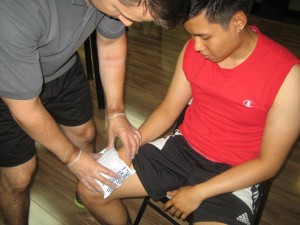When handling pain and injuries, the most common question that is always asked – will I use heat or ice? Understandably, it depends on the injury that was sustained by the individual. Both heat and ice are beneficial at different times. http://youtu.be/AogsIRrE-W8
Using ice on injuries
When it comes to the safest choice for treating injuries, the best first aid option is always ice. The application of ice is the preferred choice for injuries or pain that is less than 24 hours old or any injury that continues to generate swelling.

Once ice is applied, it helps reduce the amount of swelling that occurs right after an injury was sustained. It also provides a soothing effect on the nerves which helps diminish the pain. Take note that ice or cold packs must not be placed directly on the skin since there is a risk for frostbite. In reality, cold packs are even colder than natural ice. Do not use ice or ice packs longer than 30 minutes and the affected limb must be elevated when iced for efficient treatment of the swelling.
Tips when using ice
- Soak a washcloth in cold water and wring it out before placing over the affected area. Place an ice pack or frozen vegetable on top.
- Rub an ice cube over the affected area until it completely melts.
- If the affected areas involve the feet or hands, soak in a bowl or bucket of icy water for 10-15 minutes.
Using heat on injuries
When heat is used, it promotes the relaxation of muscles and ideally used on postural muscles such as those in the middle back, lower back and the neck. Muscle spasms and soreness are the common symptoms that can be treated with heat. Just make sure that heat is applied only on 30 minute intervals. Once heat is applied over an acute injury, the swelling or inflammation will only worsen since heat causes vasodilation which is the opposite effect of ice. Burns can also occur if heat is used, especially heating pads. Moist heat is considered an effective form of heat.
Tips when using heat
- Do not apply heat for more than 30 minutes.
- You can use an electric heating pad if available.
- The setting on the heating device must be at the minimum in order to prevent burns.
- Apply a cloth between the skin and heating pad.
Important tips to bear in mind
Alternating heat and ice is commonly practiced among athletes who want to minimize the swelling quickly. The method helps promote the opening and closing of the blood vessels to pump the swelling out of the affected area. Just remember that this method is not used to minimize the pain. Whether applying heat or ice, if a repeat session is required, you have to wait until the skin is back to its normal appearance and temperature. This usually takes 30-60 minutes depending on the response of the individual. Do not apply heat or ice again unless the skin has fully recovered.
